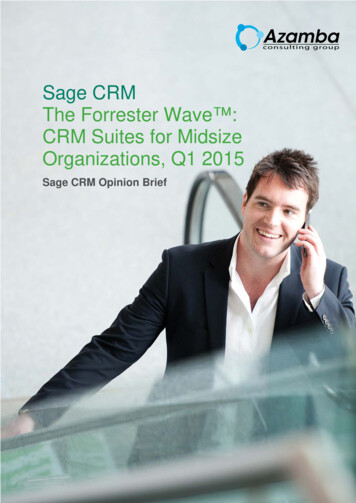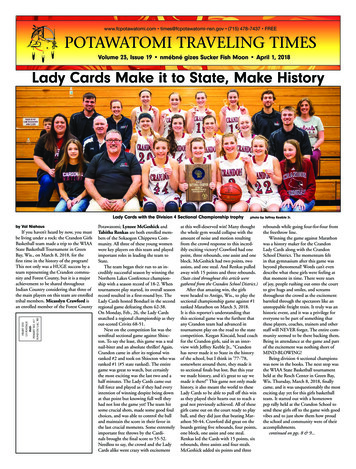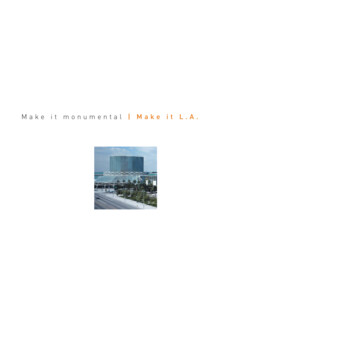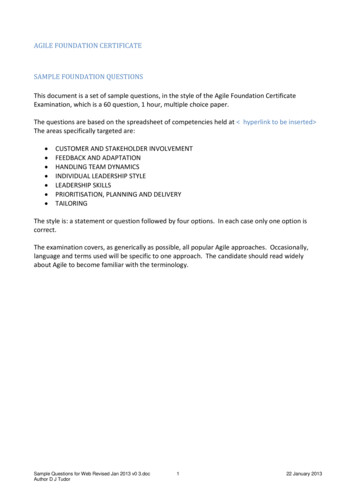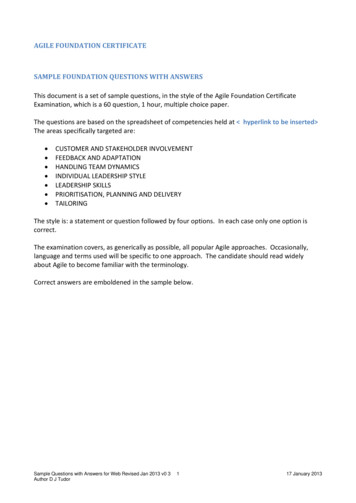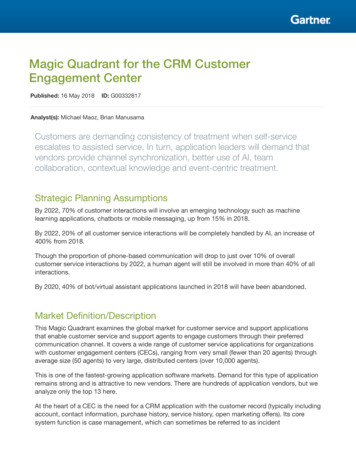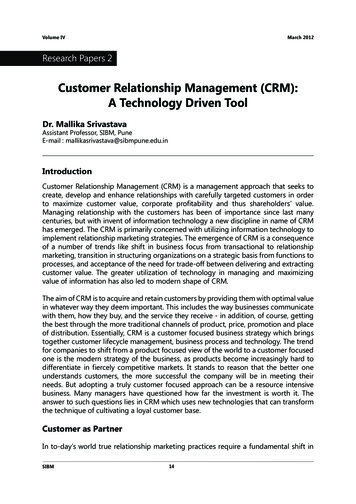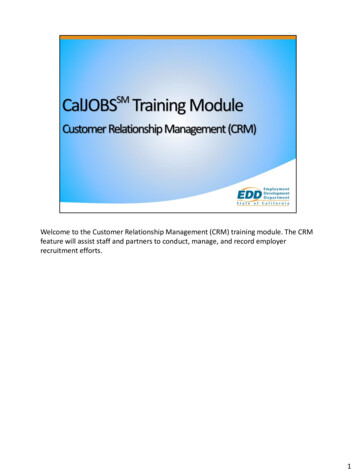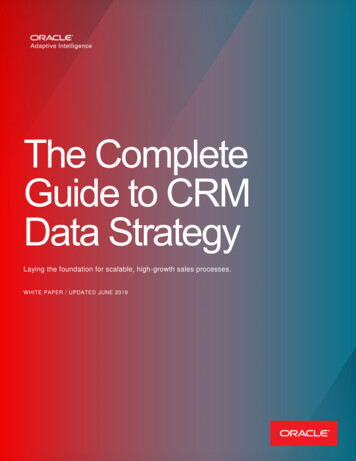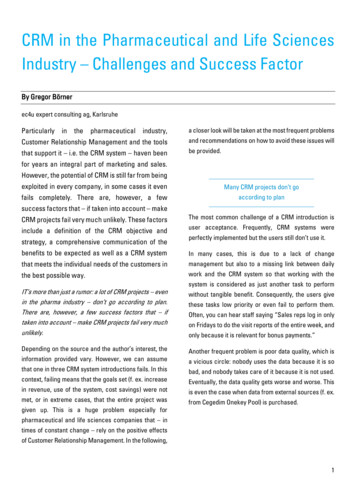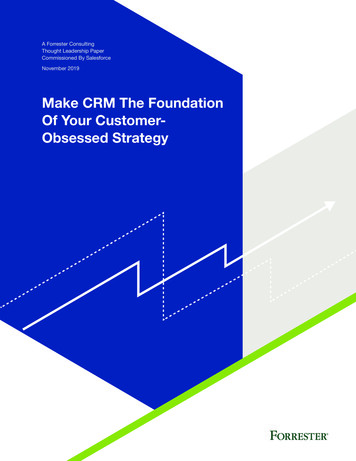
Transcription
A Forrester ConsultingThought Leadership PaperCommissioned By SalesforceNovember 2019Make CRM The FoundationOf Your CustomerObsessed Strategy
Table Of Contents1 Executive Summary2 Challenge 1: CRM Systems AreOften Used In Silos4 Challenge 2: CRM Systems AreUnderutilized5 Insight 1: CRM Systems Can BeThe Single Source Of Truth ForBusinesses And Propel CustomerExperience Efforts Forward7 Insight 2: Companies On This PathAre Already Supporting SuperiorCustomer Experience8 Key Recommendations9 AppendixABOUT FORRESTER CONSULTINGProject Director:Ana Brzezinska,Market Impact ConsultantContributing Research:Forrester’s ApplicationDevelopment & Deliveryresearch groupForrester Consulting provides independent and objective research-basedconsulting to help leaders succeed in their organizations. Ranging in scope froma short strategy session to custom projects, Forrester’s Consulting servicesconnect you directly with research analysts who apply expert insight to yourspecific business challenges. For more information, visit forrester.com/consulting. 2019, Forrester Research, Inc. All rights reserved. Unauthorized reproductionis strictly prohibited. Information is based on best available resources.Opinions reflect judgment at the time and are subject to change. Forrester ,Technographics , Forrester Wave, RoleView, TechRadar, and Total EconomicImpact are trademarks of Forrester Research, Inc. All other trademarks are theproperty of their respective companies. For additional information, go toforrester.com. E-44064
Executive SummaryToday’s customers have a new set of expectations for their interactionswith businesses. They want an easy, personalized experience, whetherit’s in person, over the phone, or on a mobile device. Businesses mustmeet these expectations to entice customers to stay loyal to theirbrand. This will ultimately boost customer retention and companyrevenue.80% of businessleaders state thata single sourceof truth wouldbe significantlyvaluable forcustomer dataMany organizations use customer relationship management (CRM)as a foundational technology to help them deliver great customerexperiences. Forrester defines CRM as the technology that supportsthe key activities of targeting, acquiring, retaining, understanding, andcollaborating with customers. Today’s CRM systems cover marketing,sales, and service, but often as separate initiatives. However, a growingnumber of businesses are positioning CRM at the center of theirorganization. The result has been a unified view of each customer thatis translating to improved experiences and faster growth.In October 2019, Salesforce commissioned Forrester Consulting toevaluate the use of CRM systems across a wide range of industries.Forrester conducted an online survey of 484 people with decisionmaking responsibility for CRM strategy at their organization. This studyshowed that businesses that use CRM across a range of teams havehigher customer satisfaction metrics and better alignment acrossdepartments.KEY FINDINGS› Businesses require a single view of the customer in orderto achieve their customer-engagement goals. Strengtheningengagement efforts and creating seamless customer experiences aretop priorities for many businesses over the next 12 months. The keyto making this happen is providing employees with easy access torelevant information about customer interactions with the business.› Many businesses struggle with compiling this singlecomprehensive view. Only a quarter of respondents believe theirCRM system(s) provide them with a single source of truth about theircustomers. This is the case even though 80% said the functionalitywould be significantly valuable in delivering the types of customerexperiences that drive competitive advantage.› The solution is a single CRM system that delivers customerinsights across lifecycles and employee groups. Eighty-fivepercent of decision makers agree that a CRM system should supportthe full customer lifecycle, and 80% are increasingly using their CRMas a single source of customer truth.1 Make CRM The Foundation Of Your Customer-Obsessed Strategy
Challenge 1: CRM Systems Are OftenUsed In SilosSimply put, today’s customers hold the power in business relationships.They have more choices of brands, products, communication channels,and touchpoints. They demand smooth engagement, delivered inthe context of their current journey, with a full understanding of theirpreferences and prior interactions with a business.Companies must meet these customer expectations in order toearn their satisfaction and long-term brand loyalty. Great customerengagement drives retention, enrichment, and advocacy — all of whichhave a quantifiable, positive impact to topline revenue.1 Yet, despite allthe new communication channels and touchpoints, companies struggleto make this work.Many business leaders see CRM systems as crucial to the successof their marketing, sales, and customer service teams, but regrettablythose teams are often operating in their own silos. The business fallsshort when all teams don’t see the value of their CRM system as theengine supporting end-to-end customer experiences. Our surveyshowed:› Businesses need to invest in a unified view of the customerin order to meet their customer-focused initiatives. Improvingengagement efforts and delivering superior experiences acrosschannels are the top two customer-focused initiatives that surveyrespondents are prioritizing over the next 12 months. Both goalsrequire a unified view of the customer that department-level CRMsystems cannot support.› Historically, departmental buyers have purchased CRM inisolation to solve a single business problem. A majority ofrespondents (57%) reported that CRMs are at least somewhatfragmented across the organization, with a few, many, or alldepartments having their own CRM. This is a result of departmentspursuing initiatives in silos — such as modernizing sales, customerservice, or existing applications. To meet their customer-focusedinitiatives, businesses need to think bigger.› Today, CRM is often locked in separate marketing, sales, andservice team workflows. The most common use cases for CRMsystems are marketing and engaging with customers, collecting basicaccount information, and sales forecasting (see Figure 1). Lookingahead, there is a clear path to a more holistic CRM system thatcan leverage artificial intelligence and machine learning (AI/ML) toaugment day-to-day employee workflows.› Limited CRM usage across customer lifecycles furtherunderscores a missed opportunity. CRM usage is heavilyconcentrated across teams during the discover phase, or, whensales teams are reaching out to customers, marketers are loggingtheir efforts in new campaigns, and IT and finance are inputting newcustomer information (see Figure 2). However, during the explore,buy, use, ask, and engage phases, CRM usage is siloed in marketing,sales, and customer service/support teams.2 Make CRM The Foundation Of Your Customer-Obsessed Strategy57% reportedthat CRMs are atleast somewhatfragmented acrosstheir organization,with departmentshaving their ownCRM.
gehtgehtFigure 1“What are the primary use cases for your CRM system(s) today? How do you anticipate usingyour CRM system(s) in the next 2 years?”We use CRM for this today.We don’t use CRM for this today, but plan to do so in the next 2 years.Marketing and engaging with our customersdirectly through our system58%Collecting basic account and contact information57%27%32%Sales forecasting/lead-to-revenue management53%32%Supporting/servicing our customers post-sale53%31%Identifying new sales opportunities51%31%Project management51%31%Sharing customer information via internalcommunities/forums49%33%Executing complete online commerce transactions48%32%Augmenting day-to-day employee processesthrough AI/ML recommendations39%Automating outreach to customers/prospectsthrough AI/ML recommendations38%43%41%Figure 2“During which stages of the customer lifecycle do the following departments use your CRM system(s)?Showing teams most likely to engage with their CRM system in each stage of the customer lifecycleDISCOVEREXPLOREBUYUSEASKENGAGECustomer 39%26%31%Sales, including sales ops35%40%39%50%30%39%Marketing, including digital,social, corporate, and 34%44%31%37%26%33%Base: 484 director-level and above decision makers with responsibility for CRM strategy and technology investmentsSource: A commissioned study conducted by Forrester Consulting on behalf of Salesforce, August 20193 Make CRM The Foundation Of Your Customer-Obsessed Strategy
Challenge 2: CRM Systems AreUnderutilizedCRM systems are often relegated to being the sidekick, when theycould really be the star. This is because companies undervalue thefull capabilities of a CRM system as a strategic technology to supportbusiness transformation. There is often siloed access to CRM systemsor multiple CRMs within a company, so the system cannot be the singlesource of truth. Also, the data that is entered is often incomplete andstructured in a way that is unclear and inconsistent to all customerfacing personnel. We found that:› Customer-focused employees waste time making sense of datafrom disparate sources. The majority of respondents agreed onthree things:1. Customer/prospect and account data comes from too manysources, so it’s difficult to make sense of it.2. The lack of an enterprise view of customer/prospect data is aproblem.3. Employees struggle to produce insights, despite havinganalytics tools at their disposable (see Figure 3). Businessesneed insights that drive behavior. Examples include helpingmarketers target the right segments with the right offers at theright time, and helping sellers focus on deals that are more likelyto close.› Creating a single view of the customer is a pain point forbusinesses. Forty-three percent of respondents stated that creatinga single view of the customer across multiple systems/applicationsis their biggest customer experience challenge. Without a single hubfor data, businesses are forced to work across multiple systems toextract insights. This creates workflow bottlenecks and errors thatcould lead to compliance fines.2› Less than one-third of respondents reported that their CRMsystems support customers through their entire journey. Only32% said their CRM can support the entire customer lifecycle, fromdiscovery to engagement/retention. Just 25% believe their CRMsystem provides a single source of truth today.However, there is a clear demand to evolve CRM systems to beengines of unified customer insight. Eighty percent of respondentsnoted that a single source of customer truth would create“significant” or “indispensable” value for their company (see Figure 4).43% of respondents notedthat creating a single view ofthe customer is the top CXchallenge they face4 Make CRM The Foundation Of Your Customer-Obsessed StrategyFigure 3“How well does your CRMsystem support customerlifecycles from discovery toengagement/retention?”32%Completely“To what extent do you feel yourCRM system(s) provide(s) asingle source of truth today?”25%Completely“How much value would yourorganization gain from a singlesource of truth for customer data?”80%SignificantvalueIndispensablevalueBase: 484 director-level and abovedecision makers with responsibility forCRM strategy and technology investmentsSource: A commissioned study conductedby Forrester Consulting on behalf ofSalesforce, August 2019
Figure 4“Please indicate your level of agreement with the following statements.”Strongly agree/agreeCustomer/prospect and account data comesfrom too many sources to easily make sense of it.58%Lack of an enterprise view of customer/prospect data is a problem.58%I have a lot of analytics tools at my disposal, but Istill struggle to produce and execute insights.56%Customer/prospect teams cannot accessactionable insights in real time.56%Organizational silos negatively impact the qualityof our customers’/prospects’ experience.My team lacks the right analytics skills toproduce actionable customer/prospectinsights from our CRM data.I don’t have the right set of analytics tools toproduce actionable customer/prospect insights.Base: 484 director-level and above decision makers with responsibility for CRM strategy and technology investmentsSource: A commissioned study conducted by Forrester Consulting on behalf of Salesforce, August 2019Insight 1: CRM Systems Can Be The SingleSource Of Truth For Businesses And PropelCustomer Experience Efforts ForwardBusinesses are trying to close the gap between their goal of deliveringexceptional customer experiences and their reality of having disconnectedoperational systems that house customer data. Decision makers increasinglyview their CRM system as the means to getting a unified view of a customer.Our study confirmed this evolution by revealing:› Businesses recognize the value of a CRM system as the centerpiece oftheir customer engagement strategies.1. Eighty-five percent of respondents noted that a CRM system shouldbe the technology that supports their full customer lifecycle.2. Eighty percent recognize that although CRM has been relegated tosales and service today, it has far greater utility than only supportingthose two teams (see Figure 5).5 Make CRM The Foundation Of Your Customer-Obsessed Strategy56%52%49%
3. Four in five companies are already working to move CRM to theforefront — 80% agreed that their organization is increasingly usingtheir CRM system as the single source of truth to support customerfocused strategies.› Heavy CRM investments further underscore the increasedimportance of CRM in supporting customer experience. The valueof CRM is spreading far beyond marketing, sales, and service silos. It isbecoming a lynchpin of customer centricity to fuel business growth.1. Two-thirds of businesses noted that scaling their CRM systemwith business growth is a top organizational priority.2. This priority carries even more weight for enterprises (75%rated it as high or critical) than small and medium-size businesses(SMBs) (60%). Sixty-six percent noted that they are investing in newtechnologies to improve customer experience over the next twoyears, and 90% of respondents feel their CRM system is importantor very important to achieving that goal.› Easy integration and setup are critical in a CRM system. Businesseswant a CRM system that is low-cost and also easily integrates withtheir existing systems. Companies rely on a wealth of mission-criticaloperational systems, such as core banking systems, electronic healthrecords, accounting, enterprise resource planning (ERP), and supplychain management solutions. In order for CRM to be a single source oftruth, the system must easily integrate into these other solution sets.Also, respondents seek CRM systems that can be set up quickly tosupport their processes end to end. Systems must augment and enhanceworkflows, not hinder them.Figure 5Strongly agreeAgree“I believe a CRM system should bea technology solution thatsupports the full customerlifecycle.”85%“Our CRM system has significantlygreater utility beyond sales andcustomer service/support.”80%“My organization is increasinglyusing our CRM system as thesingle source of truth about ourcustomers.”80%Base: 484 director-level and above decision makers with responsibility for CRM strategy and technology investmentsSource: A commissioned study conducted by Forrester Consulting on behalf of Salesforce, August 20196 Make CRM The Foundation Of Your Customer-Obsessed Strategy
Insight 2: Companies On This Path AreAlready Supporting Superior CustomerExperienceCompanies that are integrating their CRM systems with core operationalsystems, to provide a single source of customer truth, are betterpositioned to deliver seamless experiences. And, when companiesevangelize that customer truth throughout their organization, customersget consistent experiences from everyone they interact with — whetherit’s marketers, sellers, customer service agents, or finance.Figure 6Strongly agreeAgree“Our CRM system is instrumental inmy organization’s ability to deliverseamless experience.”80%Our analysis proved that:› Well-integrated CRM systems support better customerexperience.1. Eighty percent of well-integrated businesses reported an eightor higher on a 10-point scale when rating their overall experiencefor customers, as compared with 57% of organizations whosetechnologies were not well-integrated with their CRM platform.Well-integrated businesses are those that are using many CRMcapabilities, reporting that these capabilities are integrated eitherfrom their CRM provider or heavily integrated into their CRMsystem(s).2. Additionally, 87% of businesses that have integrated all oftheir customer-facing technologies with their CRM platformnoted that their CRM system is mostly or completely able toprovide a single source of truth, as compared with 67% ofbusinesses that are not well-integrated.› CRM provides the tent pole for coordinated customerexperiences. Businesses that noted all teams use their CRM systemduring the customer lifecycle reported significantly higher ratings ofcustomer experience.1. Sixty-eight percent of those advanced users reported aneight or higher on a 10-point scale, compared with only 48% ofbusinesses that have only some teams using their CRM system.2. Eighty percent of businesses agreed that their CRM systemis instrumental in their organization’s ability to deliver seamlessexperiences.3. Seventy-seven percent noted that their CRM system is beingused by an increasingly broad swath of teams to influencedecisions (see Figure 6).7 Make CRM The Foundation Of Your Customer-Obsessed Strategy“In the next 3-5 years, I expectCRM use to expand beyond salesand service/support.”79%“Insights from our CRM system areused by an increasingly broadswath of teams at our organization.”77%Base: 484 director-level and abovedecision makers with responsibility forCRM strategy and technologyinvestmentsSource: A commissioned studyconducted by Forrester Consulting onbehalf of Salesforce, August 2019
Key RecommendationsForrester’s in-depth survey of CRM and customer experience decisionmakers yielded several important recommendations:Put the customer at the center of your operations. The bestcompetitive strategy is one that obsesses with understanding,connecting with, serving, and delighting customers. Having oneunified CRM that serves all departments can help exceed customerexpectations at every step of the journeyEmpower all customer-facing personnel with unified CRM access.With customers increasingly using self-service, there are feweropportunities for engagement with frontline personnel such as sellers,account managers, and service agents. These human relationshipsmatter and can positively influence customer retention and companyrevenue. It’s imperative to empower customer-facing personnel withthe same view of the customer, their actions, and interactions with yourcompany so that each conversation can build on the success of theprior one.Bolster customer profiles. It’s important to extend the consolidatedview of the customer with actionable intelligence gleaned fromunstructured interaction data. This will allow for true one-to-oneconversations. The data that fuels intelligence includes, but is notlimited to:1. Broader demographic and firmographic data2. Conversational styles3. Buying indicators4. Social data5. Relationship graphs6. Influencer relationshipsEmbrace AI and automation embedded in CRM. These technologiesoffload administrative work from customer-facing personnel and makeoperations more effective. They also arm organizations with the rightcontent, data, and insights to personalize engagement and optimizeproducts and services — all of which drive customer retention andcompany revenue.Think beyond CRM. CRM users on the frontlines can’t serve customerswho are using only co
evaluate the use of CRM systems across a wide range of industries. Forrester conducted an online survey of 484 people with decision-making responsibility for CRM strategy at their organization. This study showed that businesses that use CRM across a range of teams have higher customer sati
